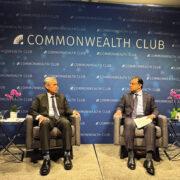PHILIPPINE Transportation Secretary Art Tugade was recently crucified in mainstream and social media for reportedly attributing Manila’s monstrous traffic to “a state of mind.”
Subsequent clarification of what Tugade really meant appears to have been an exercise in futility. In communications, there can be a huge gap between what you say and how you are understood. One single statement can be understood in ten different ways by ten different people — in addition to mischievous media folks who purposely misunderstand.
According to Cherie Mercado-Santos, transportation assistant secretary for communications, Tugade actually said, “The prevailing Filipino psyche of using traffic as an excuse must be changed. That kind of state of mind that automatically uses traffic as an excuse unnecessarily adds to the problem of traffic.”
I actually agree with the good secretary, although I think that his observation left him unnecessarily vulnerable to being misunderstood. Metro Manilans are in no mood to listen to why they, too, must do their share in alleviating their traffic problem.
I shuttle often between my home in the San Francisco Bay Area and Manila, and was here recently on a brief stopover from Bangkok. In that very quick visit, I had a 3:30 p.m. meeting and a 10:00 a.m. brunch, both on a weekday and both at Serendra in Taguig. For both engagements, I arrived a few minutes early and the folks I was supposed to meet with arrived on time.
From my home in Paranaque, just off Sucat, it would normally take less than 30 minutes without traffic. But I allowed two hours of travel time to make sure that I would not be late.
Don’t think I only do this in Manila. I do it too in California. From my home on the East Bay to my office in Daly City, it normally takes 30 minutes without traffic – that is, in the dead of night. But in the daytime, it takes two hours to the office and two-and-a-half going home.
Now, if you live in the Los Angeles area, two hours or two-and-a-half are not enough allowance if you don’t want to be late for an appointment. The saying is that the Los Angeles freeway system is one big parking lot. That’s how bad the traffic is. But the media and the folks in California have learned to adjust, instead of blaming the government. The government is, of course, scrambling to get ahead of urban sprawl and the resultant traffic problems, but many times, its best efforts are not enough.
And talking about “state of mind,” Metro Manilans can learn a lesson from the folks in Honolulu. They have a term there, shaka, which loosely means, “hang loose” or “relax.”
I learned what that really meant some years ago when I frantically rushed to a lunch appointment with an advertising client in the middle of the usually bad Honolulu traffic. By pleading with the taxi driver and literally dashing up the stairs of the office building (I couldn’t wait for the elevator), I made it to my client’s office “on the dot.” Guess what? My client arrived an hour late.
“Hang loose, Greg,” he said breezily. “You are in Hawaii.”
For sure, Tugade and his colleague in the Duterte cabinet, Secretary Mark Villar of the Department of Public Works, have to act creatively and double-time to lessen the torment that Manilans have dubbed carmageddon. Rationalizations like Mar Roxas’s classic, “It’s a sign of economic progress” and former DOTC Secretary Abaya’s “it’s not fatal,” are what Pinoys call, “consuelo de bobo.” Tugade’s “state of mind” comment falls in the same category.
Suffering Metro Manilans are simply in no mood to listen to reason, no matter how logical. We are so used to blaming everyone else but ourselves. It also makes matters worse when we have a society where each one does his own thing, and let the devil take care of the rest.
For instance, A. Santos Avenue, better known as Sucat Road, is the closest thing to traffic hell during drive time, which is early in the morning and late in the afternoon. So what does Maynilad, the water company do? It appropriates half of an already narrow road, blocking off long stretches, in order to lay water pipes.
This is not to say that Maynilad’s pipe-laying activities are unnecessary (would we rather be without water?). But couldn’t there have been some way of lessening the torment?
When the San Francisco International Airport was expanded and when the Oakland portion of the San Francisco-Oakland Bay Bridge was built, the professionals who handled the construction made provisions for alternative thoroughfares so that people were hardly inconvenienced.
Of course, it must have cost more money (for instance, a temporary span was built on the Oakland section of the Bay Bridge while the new span was being constructed) but the added financial cost was factored in relation to the opportunity cost or loss of productive manhours if traffic jams had resulted.
On a trip to my home province of Leyte last year, I noticed that the bridge on the main road approaching Palo, coming from Tacloban, was being constructed. I also noticed that an alternative road was opened to keep traffic flowing smoothly.
To go back to the Sucat Road traffic hell, there are gated subdivisions in the area which could be opened up, at least temporarily to lessen the volume of traffic pouring into Sucat while the Maynilad construction is going on (for instance, from San Antonio Valley One, where the Paranaque City Hall is located, through the two adjoining subdivisions, which both require stickers for passage). And the morning and early evening traffic going through San Antonio Valley into Better Living and on to the Bicutan interchange could probably be lessened if trucks were prohibited from passing through.
I understand that the “emergency powers” being requested by the Department of Transportation is meant to give it the legal muscle to require exclusive subdivisions to open up their sanctum sanctorums.
But using the term “emergency powers” is ill-advised. This is another case of poor communications. The term evokes images of martial law and scares the wits of average folks. Couldn’t Tugade and his team just specify the villages they would like opened up temporarily and the conditions for opening them up (such as not allowing jeepneys, tricycles, buses and trucks to pass, as well as ensuring optimal security)?
I mentioned earlier that I flew to Manila from Bangkok. I spent a few days there and noted the heavy traffic pouring in and out of the city – this in spite of the impressive network of elevated freeways (similar to Metro Manila’s skyways) that stretch for miles. But I also noticed how orderly the vehicles were and, even more remarkable, was the absence of traffic policemen in the major thoroughfares.
Compare that to the large number of MMDA traffic enforcers and policeman (in addition to pito boys or people with whistles helping vehicles back out of parking slots to get back on the main road) and you realize that we Pinoys are such terrible pasaways (undisciplined) that we need to have enforcers virtually cracking the whip on us.
The trouble is that many of these so-called enforcers simply turn a blind eye to jeepneys picking up and dropping off passengers in the middle of the road and blocking traffic. In fact, it seems to me that these enforcers know only one rule to enforce – the color coding (or number coding) ordinance. Everything else is puede na.
There is supposed to be major relief from our traffic woes once the SLEX and NLEX freeways are connected and the Department of Public works opens the network of overpasses leading to the airport terminals and the Bay City area where the new casinos are located.
But that relief will only be temporary. I recall the days when EDSA had no light rail trains traversing it and there were no overpasses and underpasses. Traffic was terrible. Now that those structures and the train system are in place, the traffic is still terrible.
One day, we will see flying cars and taxis crisscrossing Metro Manila. Will that bring relief from our traffic woes? Of course. But only temporarily. We will always find a way to make a good thing bad. It’s a state of mind. So hang loose. Or in Taglish, Relak para hindi ka mag-kolap. ([email protected])









Thanks for the post!!